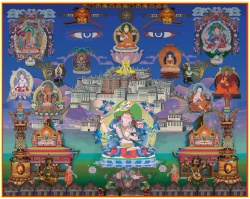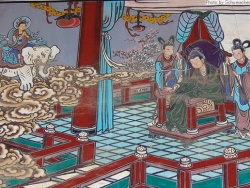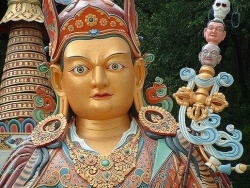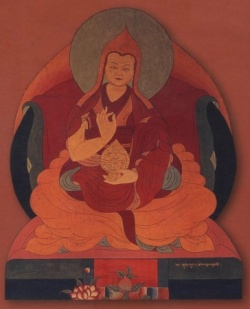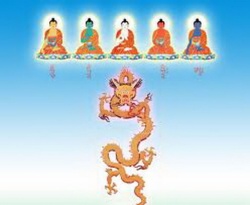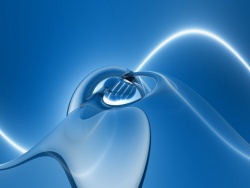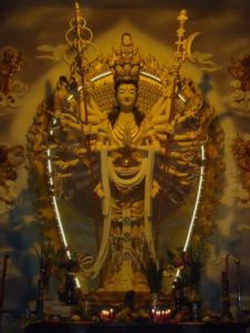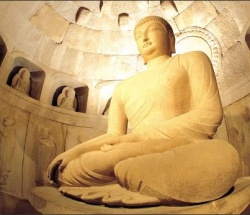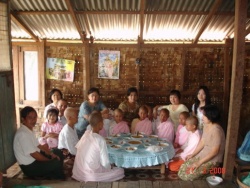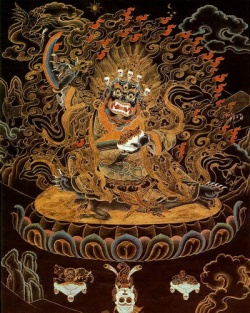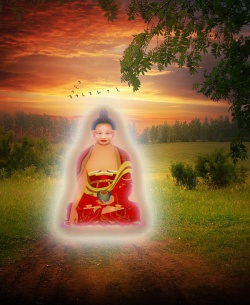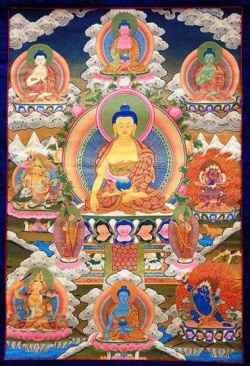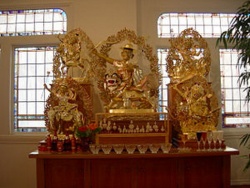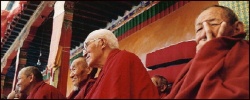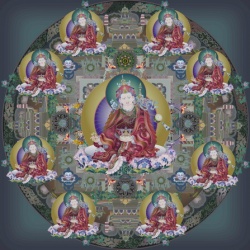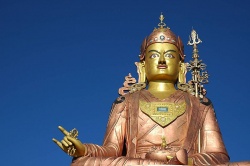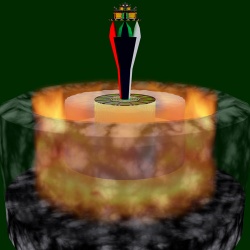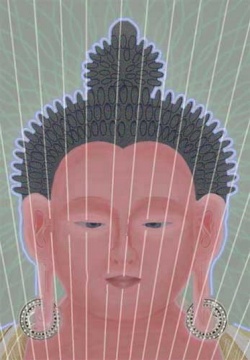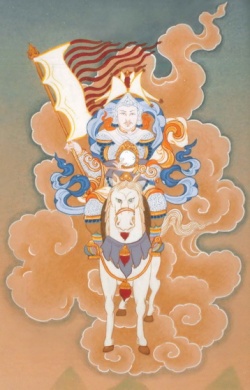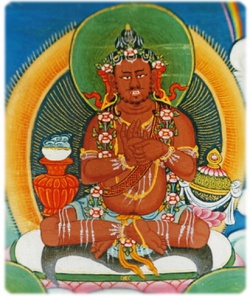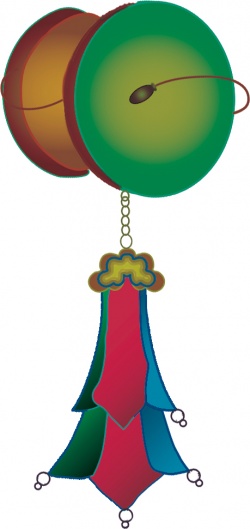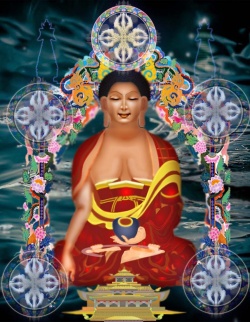Dream yoga
Click here to see other articles relating to word Dream yoga
We spend a third of our lives asleep; so it is quite useful that we use that period if we can. If your practice is only your formal practice, then a very small part of your life is actually devoted to practice.
This is crucial for anyone who lives in the world and has a job. This is why we teach dream yoga – it is important that we use that part of our lives.
There are many different styles of dream yoga. I am going to introduce a particular one which uses three syllables.
Dream yoga syllables
These three syllables are gTérmas that represent three different practices of dream yoga. The first is called an a-chung, or little a; the sound is short and goes up.
The a-chung is fairly common in all traditions; but the syllable in the middle – the white A – is a peculiar form that is only found in the Aro gTér in terms of that shape.
Its sound is the regular A. Also the A’a’a at the bottom is peculiar to the Aro gTér.
It is like the A’a in Om, A’a: Hung, but it has an extra a-chung on the bottom. Its sound goes down, and it is longer. It is an aspect of this tradition that the shapes of these are connected with the tiglés.
Tiglés are aspects of the sub-atomic structure of being; they are the essence of the elements.
They are conceptualised, at least, as spherical. If you look at these particular syllables, they have a somewhat distorted appearance of a syllable seen through a glass sphere.
The practice of dream yoga is one of falling asleep with awareness. It is interesting how we use that term ‘falling asleep’. One does not creep asleep, or climb asleep or jump asleep – one falls asleep.
I always find language interesting, because it often talks about our experience that is hidden in the words at some level.
This idea of ‘falling asleep’ is tied in with how we practice; because when we move into the sleep state, the elements dissolve into each other.
The psychophysical elements are earth, water, fire, air and space. When we go to sleep—or when we die—these elements dissolve into each other.
The earth element dissolves into the water element, which dissolves into the fire element, which dissolves into the air element, which dissolves into the space element.
The space element dissolves into itself – and we are either unconscious or dead.
The processes of falling asleep and dying are practically identical, apart from the fact that you return to your same body the next day; you do not wake up in a new one.
There are experiences which go along with these dissolutions. I will speak of the first one; because many people will have experience of the first dissolution.
If you have knowledge of that, then it is quite inspiring in terms of how you approach this practice – you know that on some occasions you have started to practice in this way.
The dissolution of the earth element into the water element is accompanied by a sense of loss of contact with your physical form.
You are lying in bed, and you have a sense in which something is different – you have the sense ‘I will be asleep soon’.
The thought may also occur to you that ‘If I wanted to move a limb, I would have to make a slightly unusual effort to do that.
I would have to put my awareness into that limb in order to move it’. One feels slightly removed from having a body; one feels very heavy.
This is the dissolution of the earth element. It is important, if you are going to experience this, that you not fall asleep as soon as your head hits the pillow; then, for most people, the experience of ‘falling’ will start.
The experience of falling, or vertigo, is interesting. How do you experience vertigo without falling? Perhaps you could go to the top of a high building and stand on a window ledge and look over.
In order to experience vertigo without falling, you actually might have to put a strap around yourself and lean outwards.
Here—with falling asleep—what is required is some rope or harness that is going to stop us from falling.
This is the principle of these particular syllables – we visualise one of these syllables in order to pin our awareness, when we are moving into the sleep state.
This is how you visualize them: each syllable is surrounded by an opalescent sphere of light, that is swirling and moving.
The opalescent sphere contains the five colours:
yellow,
white,
red,
green and
blue
that are moving like clouds around the sphere. Within the sphere you visualise one of these syllables.
The a-chung (’a) is dark blue in colour and is visualised a hand’s span above the head.
It is visualised the size of a very large pea, or a small cherry tomato. This is one style of practice. The white A is at the throat, and about the size of a grapefruit.
The red A’a’a is at the heart and about the size of a small squash.
Each is a separate practice – when you are going to sleep, you use one of these three methods.
What I suggest is that you look at these syllables and—first-thought, best-thought—whichever one appeals to you, practice that. Maybe try something different tomorrow night, if that did not work out. Then I would generally stay with one for a month and see what happens, before changing it.
The style of visualisation is quite peculiar; it comes in two stages.
The first is called ‘triangular-fixation’, which means that you visualise extremely sharply so that you put some strain into the body.
You might strain physically, you might grit your teeth, in order to see this. You concentrate with strength and tension.
That lasts for only ten to fifteen seconds.
Then you relax the visualisation completely and remain in the presence of it. This is a bit like when the sun is in the sky, and you look at it quickly – you get an after-image.
It is that style of visualisation – a flash on and off. You are left with an after-image, and you remain in that state. It is no effort to keep that after-image there; it simply remains.
Q: Do you intone the sound of the syllable when you do the visualisation?
NR: No, here it is simply the visualisation. That is the first part: how we visualise.
Then there is the posture, in which you lie on your side with the top leg pulled up and over – this keeps you from rolling onto your stomach.
You can put your arms wherever you like. Sleeping on your side is connected with the channels.
The solar channel is female; the lunar channel is male. The lunar channel, which is connected with activity, is open and on top;
dream yoga is activity.
Because the channels are are on reverse sides in females and males, women sleep on their right side; men on their left side.
Sleeping lightly is very important if one is to have any awareness in the dream state. You can apply various measures in order to do so.
You can adjust the amount of light in the room – from having it totally dark, to having a night light on, or having all the lights on, depending on how heavily or lightly you sleep. One has to experiment with one’s sleeping environment.
If you sleep very heavily and you live in a city, it is easy – you open the curtains, and there is always light.
If that is not enough, you put on a lamp or whatever – the idea is that you keep lightening the room, until you remember your dreams in the morning. If you are not remembering your dreams, you are sleeping too heavily.
If you are sleeping too lightly—you keep waking up—you will need to darken the room. This is one way of adjusting your circumstances. The other is to raise or lower the height of the pillow: if you raise your pillow, you will sleep more lightly; if you have a lower pillow, you will sleep more deeply.
You have to find out what is ideal for you—and that alters—so you can make adjustment as to how lightly or deeply you are sleeping. Sleeping lightly is useful.
It always amuses me when someone says, "I slept like a log last night". And I say, if they happen to be a Buddhist practitioner, "Wouldn’t it be preferable to sleep like a human being?" This is important – you awake far more refreshed if you sleep lightly. This is worthwhile even if you have no dream-awareness at all.
Through the practice of visualising one of these syllables, you go to sleep in the presence of the syllable. At first there is the sharp visualisation that is called ‘triangular fixation’; and then you let that go.
It does not matter if you do not see the syllable anymore, but you remain in the presence or the after-image of it.
You will then begin to experience the dissolution of the elements, which in itself is threatening. It is more comfortable, from the dualistic perspective, to lose consciousness immediately.
To actually watch the fabric of perception disintegrate, bit-by-bit, is not comfortable. We intrinsically try to reject that by simply falling unconscious.
It is easier to either pull back from the vertigo, or to fall off the ledge. To stay in the vertigo is difficult; but that is the nature of the practice.
These three syllables ’a, A, and A’a’a are methods of helping with this.
You will find, if you try them out, that one will be more suitable than the others for you. It might not be suitable for the rest of your life; maybe you will change from time to time.
You can experiment with this—you can try them all—and you will find that one is more useful than the others – even in terms of being able to have a ‘sense’ of it.
Within the Aro gTér Tradition, this ’a, A, and A’a’a equate with Om, A’a: and Hung. We use Om, A’a: and Hung as well; but we also use this set where the colours are different. Usually they are white Om, red A’a and blue Hung.
Q: Then why are they different? Sometimes it seems devised to make it more complicated.
NR: It was not ‘devised’; so there is no why. There is no concept of complication, either. That would be a little bit like saying ‘underpants are different to socks – why is that? It makes it more complicated’.
You see, it is all method. There is no actual reality in Om, A’a: and Hung – they are methods; ’a, A and A’a’a are also methods. Within the Tantric system, there are many thousands of methods that can be used that come from different gTérma systems.
I think this variation is quite useful.
Otherwise, one starts relating to these syllables as having some essential reality in themselves – as if there were something about this that is white, red or blue. Changing them around is quite useful.
So – we fall asleep.
We follow this sequence of elements dissolving into each other. When the space element dissolves into itself, this is called the chö-nyid bardo – the bardo of dharmata.
This would be called the practice of ösel – of clear light.
In the Aro Tradition, dream yoga is :
ösel (’od-gSal – clear light),
milam (rMi-lam – dream yoga) and
gyu-lü (rGyu-lus – illusory body)
– these three of the Naro Chö druk, the Six Yogas of Naropa, are combined into one practice.
The first aspect which is called ösel, or clear light, is the point at which the elements are dissolved into each other and have evaporated.
All that is left is lucent emptiness – emptiness that is self-aware. Self-arisen awareness is there. Most of us miss this experience; we fall into unconsciousness.
The next thing that happens is the dream state, the bardo of dream, which is called ‘milam bardo’. Here we gain consciousness again.
It is interesting that the dream state works in a very different way from the waking state.
Because of this, practice is very different there.
If we look at shi-nè, the practice of silent sitting, we sit and we let go of whatever arises; we do not manipulate anything. If something arises, we simply allow it to arise, to remain, to dissolve; we do not interfere with it.
We do not force thought out; we do not force it in. We have the basic principle here of ‘I do not interfere’.
In terms of dream yoga, exactly the opposite is true – ‘I interfere’.
In the dream state, anything we might do that is reflective of emptiness would make us go into the emptiness of unconsciousness.
By ‘reflective of emptiness’, I mean non-manipulation and repetition.
The practices we might do in the waking state—sit, let go of thought, recite mantra, or chant a text—are repetitious; these are reflective of emptiness. That does not work in the dream state.
In the dream state, practices are reflective of form. We have to manipulate what arises in an inventive way. Whatever happens, we have to work with it:
I see something – I pick it up, I look at it, I throw it away, I make it turn into something else. If I am having a bad dream, I turn it into a happy dream.
I make things happen –whatever I want to happen; though bear in mind, the karmic patterning of what one creates in one’s dreams is exactly the same as in one’s waking life.
Murdering someone in your dream is exactly the same as murdering someone in your waking life in terms of karma; there is no difference. If the motivation is there to do it, that is the same motivation.
Q: Rinpoche, if you start doing that in your dream state, how do you avoid waking up? I find I seem to wake up when that happens.
NR: I think you need to adjust the level of your sleeping – you need to be sleeping a little more heavily then.
It is something you have to continually balance or change – within different periods of your life, within the seasons.
This is probably something we could discuss privately, because there are many different balances; one could look at what the elemental pulses are doing; there are different adjustments that could be made.
It is quite experimental, in terms of remaining in that state.
If you are sleeping too lightly, and you are on the border of waking up, the practice will tend to make you wake up.
Q: What sort of view do you have, if you become aware in your dream that you are dreaming—and all of these people and images are like in a movie—and you realise this is not real?
What sort of view do you have in relation to these phenomena that you are experiencing?
NR: You have a compassionate view. You treat it as real; you know it is not real, but you treat it as real.
Q: I don’t know how to do that!
NR: There is no ‘how to’ there. It is exactly the same as the practice the next morning, where you practice gyu-lü: you wake up; then everything is unreal – everything is a dream.
But you also have the practice of compassion there – even though ‘I’ do not exist, I will be kind to her… on principle!
In the dream, the same thing applies – it does not matter whether these phenomena are existent or non-existent, one’s compassion is still there.
Compassion is connection, appreciation. Whatever you are seeing, that sense of bodhicitta can manifest in terms of your connection. It is more a matter of entering into the felt-nature of the practice and knowing that that is a possibility; and simply allowing that to arise.
Q: You realise it’s phenomena of your own mind arising, and you have compassion for the process of arising? It gets boring, tiring sometimes…
NR: It is the same as waking life, which is actually the end-result of the practice – that the dream state and the waking state become seamless. That becomes the union of gyu-lü and milam – they become one state.
This is not easy to understand, by the way; this is purely experiential. On one level, to ask a question has little significance unless you experience it like that; when you start to manipulate – and people manipulate in everyday life, too…
Q: Do you mean projections..?
NR: Sure. This undermines that process. This is just the start, though.
How that process continues, traditionally, is that at first you take yourself out of bad situations in your dreams – you create pleasurable experience;
and when you are fairly solid in that, then you start threatening yourself. Traditionally one throws oneself into pits of snakes, of fire – these are the traditional Tibetan things to do.
Here, one might give a public talk… Whatever you think would be frightening in everyday life, you do in the dream while knowing it is a dream.
Q: You do that on purpose to realise it is a dream?
NR: You have to keep remembering it is a dream. A dream feels like reality, which is why in the waking state you make reality feel like a dream.
Usually it is advised that one only practises gyu-lü for a short period of time in the morning, like a half-hour; because you can make yourself very unstable with this if you do not have a very strong practice.
One has to be a little bit careful with this practice of gyu-lü.
Q: During that period, do you treat it just like it was a dream – do you manipulate?
NR: No, then you do not manipulate, because it is not the dream state.
Q: So it is just a matter of having a different view?
NR: Yes. The view is always being adjusted, according to where you are and what is happening. In the dream state you alter it, because of this tendency to fall unconscious.
I will tell a little story here about my first experience of dream yoga – it is silly, but it shows the point in a sense. I wake up in the dream and I say, "Ah! So this is dream yoga.
This is great. What am I… oh, a house – I am looking at a house". This is one of those houses I perhaps saw in a movie – an East Coast, Dutch-looking house, like in the ‘Amityville Horror’. "Right! House. Now I am going to manipulate."
The idea occurs to me that I will say, ‘House!’ and when I say it, the house will change into a totally different house that I have not anticipated. So I say, "House!" and there was another house there.
And I thought, "Right; this is good", so I said "House!" again and there was another house. And it went, "House… House… House…" gone! Because, always the tendency in the dream state is to repeat.
Like the tendency in shi-nè is to manipulate, the tendency in the dream state is not to manipulate and to be repetitive.
So I would have to have gone into the house, looked around the house – here is a cupboard, what is inside the cupboard?
I would have to keep on doing things that are different, looking, responding: ‘Right, let’s build an extra wing on the house. Where is the saw? I want some helpers now.
We’ll make the foundations…’ It has to keep changing.
Just as shi-nè leads to the state of stable shi-nè’ – the state in which thought is no longer arising;
and we move from that state into lhatong – when content of mind moves again; eventually in terms of Dzogchen, one can practise with conceptuality.
One mixes conceptuality with rigpa.
There is no problem with ordinary conceptuality either. In the dream state, once one has some accomplishment with it, one can recite mantra, one can practise as one practises in one’s daily life.
As in daily life, when one reaches a certain state, conceptual thought is practice. That can also be self-liberated into its own condition.
There is no problem with it; it is not an obstacle.
There is this reflection—this reversal—of the sleep state and the waking state.
The practice in the waking state is to let go of conceptuality, to move into emptiness; and then for phenomena to arise again – but not particularly conceptual phenomena.
One finds oneself identified with the phenomena. This is called lhatong – one simply moves.
The ultimate extension of this, into Dzogchen practice, is that everything that arises, the nature of thought, is dharmakaya.
This is a Dzogchen statement. In the dream state it is the opposite.
We start with conceptualising, with manipulation. When we become proficient with manipulation in the dream state, we are able to let go of it without so much fear of simply losing it. It works the other way around.
They are simply mirror reflections of each other in terms of practice style.
When one accomplishes that in the dream state, then the dream state and the waking state become seamless; they become the same experience. One is simply lying down or one is walking around; but one’s awareness is unaffected by that.
Q: In the dream state, when you say ‘manipulate things’, does that mean you are trying to actually manifest something with your mind? Rather than just interacting with whatever is?
NR: You can do that, too. You can do whatever you like.
It is probably best to start with physically touching things in the dream; because the tendency is to sit and observe, like it was on video.
You actually have to say ‘Oh, there is that thing there. I will reach for it and pick it up; I won’t simply sit back and watch.’ You have to interact with it.
Q: Use your sense-fields?
NR: Yes, that is important. I mean ‘manipulate’ in a mechanical sense – I pick this up, I move this across – I interact with it; so it is not me watching it out there, separate from me. Otherwise, you simply fall out of it again into unconsciousness.
Q: Are the sense fields that you experience in the dream the same as the sense fields you experience in waking state?
NR: No.
Q: How are they different?
NR: You will see.
Q: In a dream I can have the physical sensation of touching something; but I am not actually touching it, yet it seems the same….
NR: They are connected. They are all part of the same elemental pattern. When you say it is the same as touching it, even though you are not touching it, that is your memory of the dream.
What actually occurs in the dream is something different.
Once you remember it, you remember what touch is like; so your waking memory of touch animates the dream ‘touch’.
You cannot remember the dream touch; you can only put that in the pigeon-hole of waking-touch.
Q: You are expecting to have that sensation, so you are creating that sensation with your mind?
NR: Sure. It is very different. For example, this morning you said, "It is cold. I’m freezing". And I said, "Yes, my hands are cold; but I quite enjoy that". I do not like the heat; so for me, the sensation of being slightly chilly is pleasant.
Even though it is a bit uncomfortable, I would rather be a bit cold-uncomfortable than hot-uncomfortable. I project good-qualities onto cold. This is no more real than projecting bad-qualities onto cold. It is simply there.
Whatever we see, whatever we hear, fits into a box – the nearest box. I see the colour of someone’s jacket and I say, ‘that’s green’ or ‘that’s grey’. But what if I cannot decide if it is green or it is grey?
It will either be one or the other.
There is always a box for it – unless I am an artist; then I still have boxes, but I have thousands of colour boxes instead of fewer. Eskimos have all these snow-boxes; we have fewer snow-boxes.
If you are a skier, than you have rotten potato snow-box, powder snow-box – it is the perceptual box that you put the snow into. You look at it, you say ‘powder snow’.
Someone who does not ski says, ‘snow’, ‘slush’.
Eskimos have a whole series of them. You either have more or less boxes in various areas of your perception; and whatever comes along fits into a box. We never see what is there; we simply take it and put it into a box in order to understand it. It is the same with dream also.
Q: Can you talk about the dissolving of the elements in preparation for dream yoga?
NR: There is no preparation; that is simply what happens. I have spoken about the dissolution of the earth element into the water element. I do not like to speak about the others, because it pre-empts people.
Those you will experience; and they are specific. The only preparation is shi-nè – that you have to let go of what arises in mind. You have to get used to the experience of not being defined, of having no reference points.
What happens in the dissolution of the elements is that one loses reference points more and more, and awareness becomes less workable as boxes or pigeon-holes.
The whole structure of pigeon-holing starts to fall apart more and more with each element; until the space element dissolves into itself, and there are no pigeon-holes left – there is just one vast pigeon-hole.
There is no way to understand anything any more in terms of any kind of structure.
I cannot rely on it; I cannot differentiate to say, ‘This is black because that is white’. That structure is gone. The process of the dissolution of the elements is gradually losing the pigeon-holes.
Q: Then it is staying present as we are falling asleep, and experiencing that to some degree? Normally we are out of there – we don’t want to feel that groundlessness. But is it to stay present with it, and then staying with that?
NR: Yes. Now what happens when we wake up – the most important thing on waking up, is that we get out of bed immediately. We sit up. The worst possible thing we can do is drowse. If you have a repeater-alarm and you cannot avoid using it, destroy it!
You set the alarm; the alarm goes off, you wake up. You sit up immediately. It is actually not more restful to drowse.
If you need more sleep, set the alarm later.
It feels comfortable to drowse, but you get into a lot of very frustrating mini-dreamettes. You fall asleep, you wake up and you think, ‘I need to resolve that… I want to go back to that… and you start another one.
On and on and on – little fragments that are unresolved. Then you wake up completely exhausted.
This is a wooly-sock psychosis that goes on.
Now, if you are a great yogi, or great yogini, then you can drowse. But if you are regular folk like us, just sit up immediately.
Q: Just to clarify, if you are waking up several times during the night, are you sitting up each time? Or are you speaking about just when we would normally get up in the morning?
NR: When you normally get up in the morning… Although, there are always exceptions to rules. I knew a lady once who actually found it very hard to practise in the morning. But she habitually woke up at four, feeling very wide awake; and then went back to sleep again.
What she did was get up, practise for an hour, and then go back to sleep again, and wake up at seven.
That worked very well for her. It depends on you, how you are. There is no rule that can always be applied; it depends.
You may find that your best hour of meditation is between three and four in the morning. And so you have two parts of sleep, with an hour of sitting in the middle; that is also fine.
Basically, the first thing we do is sit up and regain the syllable—’a, A or A’a’a—and then sound the syllable.
As we sound the syllable—any of the three syllables—we visualise the syllable and this then expands into space until it occupies the whole of space.
As we sound it, they all sound the same, because it is an extenuated Aaaaaaaaaa.
Then one sits for awhile – however long one intends to sit – then one gets up and enters into the gyu-lü, which is everything is dream-like. I will talk more about that.
Q: Rinpoche, in the process of visualisation of the syllable, is it the tradition to dissolve the spherical visualisation into whichever syllable you’re going to visualise. Or does it instantly appear?
NR: No, it instantly appears.
Q: While you’re visualisationing the syllable, are you reciting the mantra?
NR: No, you are just visualisationing the syllable.
There are many different styles of dream yoga. Some are very complex; some are very simple. This is one of the most essential types of dream yoga.
This is according to Dzogchen style.
There are forms of dream yoga where you visualise your Lama, or resting your head in your Lama’s lap; where there are chains of As; there can be very complex visualisations.
But this is very simple; you simply visualise the syllable ’a, A or A’a’a, and that is it.
What might be helpful with this—what Khandro Déchen and I sometimes recommend—is that you place a paper on which the syllable has been drawn in a Xerox machine; you blow it up quite large; and you trace it, paint in the colour;
and you have it at the foot of your bed or on the wall. You simply stare at the syllable with your eyes wide open.
You can get as fancy about that as you like: you can get framing spots, like they have in theatres, where you get shapes of light.
You can alter them—they are either square or round—and you can have a framing spot on it; the rest of the room is dark.
You stare at this image, and then you lie down. Then you will really have an after-image of it.
As we have all this fabulous technology, there is no reason why we should not use it; so you can get as obsessed as you like with your syllable, and how you see it, and what you do with it. But basically, that is very simple.
Source
A talk given by Ngak’chang Rinpoche, Pema ’ö-Sel Ling, March 1998
Aroencyclopaedia.org
